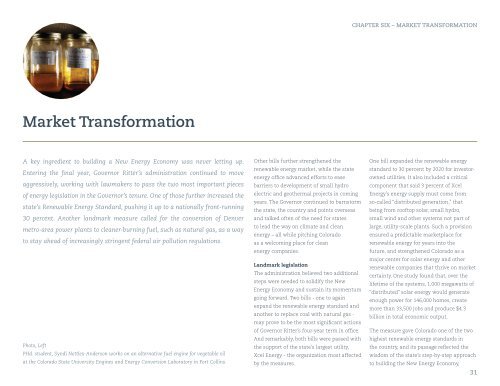A New Energy Economy - Center for the New Energy Economy ...
A New Energy Economy - Center for the New Energy Economy ...
A New Energy Economy - Center for the New Energy Economy ...
- No tags were found...
Create successful ePaper yourself
Turn your PDF publications into a flip-book with our unique Google optimized e-Paper software.
CHAPTER SIX – MARKET TRANSFORMATION<br />
Market Trans<strong>for</strong>mation<br />
A key ingredient to building a <strong>New</strong> <strong>Energy</strong> <strong>Economy</strong> was never letting up.<br />
Entering <strong>the</strong> final year, Governor Ritter’s administration continued to move<br />
aggressively, working with lawmakers to pass <strong>the</strong> two most important pieces<br />
of energy legislation in <strong>the</strong> Governor’s tenure. One of those fur<strong>the</strong>r increased <strong>the</strong><br />
state’s Renewable <strong>Energy</strong> Standard, pushing it up to a nationally front-running<br />
30 percent. Ano<strong>the</strong>r landmark measure called <strong>for</strong> <strong>the</strong> conversion of Denver<br />
metro-area power plants to cleaner-burning fuel, such as natural gas, as a way<br />
to stay ahead of increasingly stringent federal air pollution regulations.<br />
Photo, Left<br />
PHd. student, Syndi Nettles-Anderson works on an alternative fuel engine <strong>for</strong> vegetable oil<br />
at <strong>the</strong> Colorado State University Engines and <strong>Energy</strong> Conversion Laboratory in Fort Collins.<br />
O<strong>the</strong>r bills fur<strong>the</strong>r streng<strong>the</strong>ned <strong>the</strong><br />
renewable energy market, while <strong>the</strong> state<br />
energy office advanced ef<strong>for</strong>ts to ease<br />
barriers to development of small hydro<br />
electric and geo<strong>the</strong>rmal projects in coming<br />
years. The Governor continued to barnstorm<br />
<strong>the</strong> state, <strong>the</strong> country and points overseas<br />
and talked often of <strong>the</strong> need <strong>for</strong> states<br />
to lead <strong>the</strong> way on climate and clean<br />
energy – all while pitching Colorado<br />
as a welcoming place <strong>for</strong> clean<br />
energy companies.<br />
Landmark legislation<br />
The administration believed two additional<br />
steps were needed to solidify <strong>the</strong> <strong>New</strong><br />
<strong>Energy</strong> <strong>Economy</strong> and sustain its momentum<br />
going <strong>for</strong>ward. Two bills - one to again<br />
expand <strong>the</strong> renewable energy standard and<br />
ano<strong>the</strong>r to replace coal with natural gas -<br />
may prove to be <strong>the</strong> most significant actions<br />
of Governor Ritter’s four-year term in office.<br />
And remarkably, both bills were passed with<br />
<strong>the</strong> support of <strong>the</strong> state’s largest utility,<br />
Xcel <strong>Energy</strong> - <strong>the</strong> organization most affected<br />
by <strong>the</strong> measures.<br />
One bill expanded <strong>the</strong> renewable energy<br />
standard to 30 percent by 2020 <strong>for</strong> investorowned<br />
utilities. It also included a critical<br />
component that said 3 percent of Xcel<br />
<strong>Energy</strong>’s energy supply must come from<br />
so-called “distributed generation,” that<br />
being from rooftop solar, small hydro,<br />
small wind and o<strong>the</strong>r systems not part of<br />
large, utility-scale plants. Such a provision<br />
ensured a predictable marketplace <strong>for</strong><br />
renewable energy <strong>for</strong> years into <strong>the</strong><br />
future, and streng<strong>the</strong>ned Colorado as a<br />
major center <strong>for</strong> solar energy and o<strong>the</strong>r<br />
renewable companies that thrive on market<br />
certainty. One study found that, over <strong>the</strong><br />
lifetime of <strong>the</strong> systems, 1,000 megawatts of<br />
“distributed” solar energy would generate<br />
enough power <strong>for</strong> 146,000 homes, create<br />
more than 33,500 jobs and produce $4.3<br />
billion in total economic output.<br />
The measure gave Colorado one of <strong>the</strong> two<br />
highest renewable energy standards in<br />
<strong>the</strong> country, and its passage reflected <strong>the</strong><br />
wisdom of <strong>the</strong> state’s step-by-step approach<br />
to building <strong>the</strong> <strong>New</strong> <strong>Energy</strong> <strong>Economy</strong>,<br />
31


